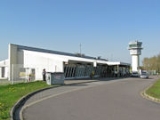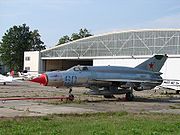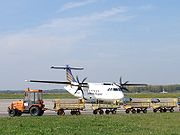
Altenburg-Nobitz Airport
Encyclopedia
Leipzig-Altenburg Airport , until February 2008 known as Altenburg-Nobitz Airport, is a German regional airport in Nobitz
, 6 km (3.7 mi) southeast of Altenburg
and 42 km (26.1 mi) south of Leipzig
in the state of Thuringia
. It is the second largest airport in Thuringia. In 2007, it served almost 140,000 passengers.
During World War One, Altenburg-Nobitz was mainly used as a production centre for German military aircraft, with Albatros, DFW, Rumpler and Fokker types all being assembled there. A military flying school was also located on the airfield.
Following the defeat of Germany, the airfield infrastructure was dismantled in accordance with the provisions of the Treaty of Versailles, and the site lay derelict until the 1930s. Following the rise to power of the Nazi Party, a decision was made to reactivate Altenburg-Nobitz as part of their rearmament plans. Work on this began in 1936; new hangars, workshops and barracks were built, and a concrete runway laid.
During World War Two, the relative remoteness of Altenburg-Nobitz from the main theatres of war made the airfield an obvious location for Luftwaffe flying training in various forms. Basic flying training was carried out, as was more advanced blind-flying and instrument training. Several types of aircraft were employed for the latter, among them the Ju-87, Ju-88, He-III, Do-17 and Me-110. The airfield was also the base for a conversion unit for the FW-190 fighter, using a special two-seat variant of this highly successful aircraft.
 With the collapse of the Reich the airfield was captured by the US Army in April 1945, being subsequently handed over to the Soviets in July, when the area came under Soviet control following the post-war territorial settlement between the Allies. From then until 1992 Altenburg-Nobitz was used as a fighter base by the Soviet Air Force. Successive types of MiG fighters were based there, principally the MiG-21 and latterly the MiG-29. The camouflaged individual blister hangars that were built for these fighters can still be seen dotted around the airfield perimeter. An anti-aircraft missile system was also installed there in 1986.
With the collapse of the Reich the airfield was captured by the US Army in April 1945, being subsequently handed over to the Soviets in July, when the area came under Soviet control following the post-war territorial settlement between the Allies. From then until 1992 Altenburg-Nobitz was used as a fighter base by the Soviet Air Force. Successive types of MiG fighters were based there, principally the MiG-21 and latterly the MiG-29. The camouflaged individual blister hangars that were built for these fighters can still be seen dotted around the airfield perimeter. An anti-aircraft missile system was also installed there in 1986.
The Soviet presence on the airfield ended in 1992 with the collapse of Communism and the radical redrawing of the political landscape which ensued. Following German Reunification a decision was made to convert the airfield to civilian use as a regional airport. Apart from the scheduled Ryanair services to the UK and Spain, Leipzig-Altenburg (as the airfield is now known) is now mainly used by general aviation and corporate aircraft. There is also a small aviation museum which chronicles the history of the airfield. Two aircraft are currently on display there, an ex-Soviet Air Force MiG-21, and an ex-Luftwaffe Breguet 'Atlantique' maritime patrol aircraft.
As of April 2011 Ryanair has ceased operations on the four times a week London Stansted route.


Nobitz
Nobitz is a municipality in the district Altenburger Land, in Thuringia, Germany....
, 6 km (3.7 mi) southeast of Altenburg
Altenburg
Altenburg is a town in the German federal state of Thuringia, 45 km south of Leipzig. It is the capital of the Altenburger Land district.-Geography:...
and 42 km (26.1 mi) south of Leipzig
Leipzig
Leipzig Leipzig has always been a trade city, situated during the time of the Holy Roman Empire at the intersection of the Via Regia and Via Imperii, two important trade routes. At one time, Leipzig was one of the major European centres of learning and culture in fields such as music and publishing...
in the state of Thuringia
Thuringia
The Free State of Thuringia is a state of Germany, located in the central part of the country.It has an area of and 2.29 million inhabitants, making it the sixth smallest by area and the fifth smallest by population of Germany's sixteen states....
. It is the second largest airport in Thuringia. In 2007, it served almost 140,000 passengers.
History
The airfield at Altenburg-Nobitz is one of the oldest in Germany. Its origins can be traced back as far as 1868, when the area the airfield now occupies was first used as an infantry drill ground. In 1881 Duke Ernst II of Sachsen-Altenburg agreed to further expansion of the site for military purposes, and in 1909 a visit was made by an early airship; the Duke was given a flight in it, and immediately became an enthusiastic convert to aviation. Two years later, in 1911, an airship display was held at the site, which also included flights by early heavier-than-air biplanes, and in June 1913 the airfield was officially established.During World War One, Altenburg-Nobitz was mainly used as a production centre for German military aircraft, with Albatros, DFW, Rumpler and Fokker types all being assembled there. A military flying school was also located on the airfield.
Following the defeat of Germany, the airfield infrastructure was dismantled in accordance with the provisions of the Treaty of Versailles, and the site lay derelict until the 1930s. Following the rise to power of the Nazi Party, a decision was made to reactivate Altenburg-Nobitz as part of their rearmament plans. Work on this began in 1936; new hangars, workshops and barracks were built, and a concrete runway laid.
During World War Two, the relative remoteness of Altenburg-Nobitz from the main theatres of war made the airfield an obvious location for Luftwaffe flying training in various forms. Basic flying training was carried out, as was more advanced blind-flying and instrument training. Several types of aircraft were employed for the latter, among them the Ju-87, Ju-88, He-III, Do-17 and Me-110. The airfield was also the base for a conversion unit for the FW-190 fighter, using a special two-seat variant of this highly successful aircraft.

The Soviet presence on the airfield ended in 1992 with the collapse of Communism and the radical redrawing of the political landscape which ensued. Following German Reunification a decision was made to convert the airfield to civilian use as a regional airport. Apart from the scheduled Ryanair services to the UK and Spain, Leipzig-Altenburg (as the airfield is now known) is now mainly used by general aviation and corporate aircraft. There is also a small aviation museum which chronicles the history of the airfield. Two aircraft are currently on display there, an ex-Soviet Air Force MiG-21, and an ex-Luftwaffe Breguet 'Atlantique' maritime patrol aircraft.
As of April 2011 Ryanair has ceased operations on the four times a week London Stansted route.

Air traffic control incident
On March 10, 2010, a Ryanair Boeing 737-800, originating from London Stansted, UK on approach to Altenburg could not establish radio contact with the tower and had to divert to Berlin Schönefeld Airport (Germany). Subsequent to the incident, it was discovered that, due to a scheduling misunderstanding, the air traffic controller scheduled had not shown up to work.Statistics

| Year | Aircraft movements | Passengers (scheduled flights) | Passengers (total) | Cargo (t) |
|---|---|---|---|---|
| 1992 | 920 | 0 | 1,983 | 0 |
| 1995 | 18,462 | 0 | 19,788 | 0 |
| 1998 | 17,720 | 0 | 27,016 | 180.2 |
| 1999 | 17,693 | 0 | 30,044 | 66.2 |
| 2000 | 17,997 | 0 | 27,764 | 131.9 |
| 2001 | 16,127 | 0 | 26,868 | 27.9 |
| 2002 | 19,543 | 0 | 26,811 | 32.1 |
| 2003 | 16,116 | 51,419 | 71,124 | 20.7 |
| 2004 | 13,978 | 76,606 | 93,870 | 12.4 |
| 2005 | 12,601 | 100,956 | 118,252 | 102.7 |
| 2006 | 12,934 | 90,551 | 105,213 | 10.4 |
| 2007 | 14,232 | 124,411 | 139,593 | 20.3 |

